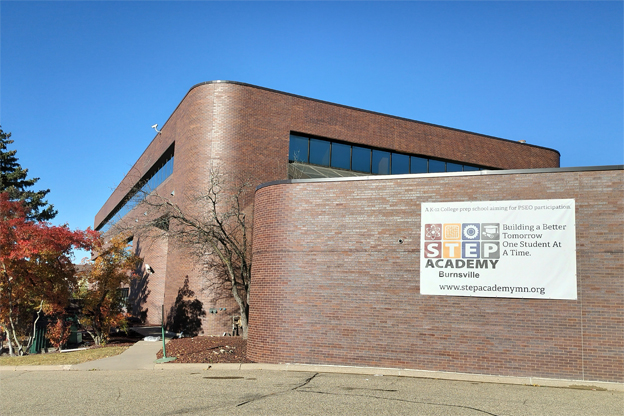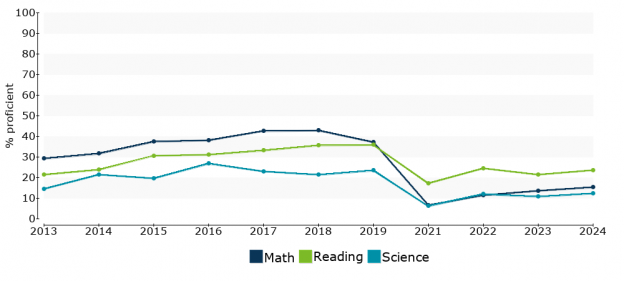

Grift and destroy
Minnesota’s charter school experiment is a failure, academically and financially
Charter schools have been in the news a lot lately, and not in a good way. Charter schools and the handful of authorizers that “authorize” many of them have come under scrutiny, recently by the Minnesota Star Tribune, and as a consequence of that, in the Legislature. As part of an omnibus education policy bill, SF 1740 in the Minesota Senate, several changes are proposed to charter school authorization and management, with a view to making them more “transparent,” and maybe a little more honest – in many cases, anyway. Here is a Senate staff summary of the bill, which is more digestible than the bill itself. The charter school provisions are in Article 3 of the bill.
The bill passed the Senate. Some legislators said that bigger changes might be on the way, but apparently that’s for another bill, another session.
There are good reasons not to put it off, though, but SF 1740 just nibbles around the edges, failing to address the central defects of the charter system.
Minnesota’s charter schools
Minnesota invented charter schools. They were supposed to be teacher and parent driven, high performing, innovative petri dishes of education. Really, with few exceptions, they turned out to be none of those things. And as we’ve learned, sometimes the contents of the petri dish die, or must find another school, anyway.
Charter schools fail for a couple of principal reasons: financial mismanagement or low student performance. We have had some spectacular examples of each, or sometimes both. Take Pillsbury United Communities of Minneapolis, for example. It was recently cited by the Minnesota Department of Education for oversight failures in nine of the 16 charter schools it authorizes. In an article on April 11, 2025, the Star Tribune had this to say:
Two of the schools were the subject of prior investigations by the Star Tribune as part of broader coverage of Minnesota charter school oversight problems: LoveWorks Academy for Arts, which shut down last year after Pillsbury United revoked its charter, and Minnesota Internship Center, which has been plagued by fraud, abysmal test scores and financial problems.
And let’s not forget the Pillsbury United authorized Learning for Leadership charter school on the West Bank that closed abruptly in 2018, stranding many Somali students who lived in high-rise apartments in the area.
Also don’t forget the Hmong College Preparatory Academy, whose superintendent made an illegal $5,000,000 investment of public money through a hedge fund that was promptly lost. Attorney General Keith Ellison is still trying to get that money back from the superintendent. HCPA was authorized at the time – I don’t think any longer – by Bethel College.
The list goes on. Really, the list goes on.
Rob Levine, the most dogged data journalist and charter school critic I know, wrote a story about the history of the creation of charter schools.
The charter school record: it isn’t very good
With a few exceptions – mostly the white flight “classical” academies – charter schools do not do well compared to comparable, real public schools.
Here’s a story from Rob about one class of charter schools and their performance: highly segregated schools supported by Great MN Schools, meaning indirectly supported by the Minneapolis Foundation. You should check out the story at the link; it’s illuminating.
Parenthetically, the Star Tribune is locked in a public data request disagreement with charter school authorizers who claim they don’t have to produce anything because they are private entities, the fact that they oversee – they are supposed to, anyway – the expenditure of millions of public dollars notwithstanding. HCPA, referred to above, receives over $20,000,000 (yes, TWENTY MILLION) in public money each year.
Hmong College Preparatory Academy is an underperformer, too.

HCPA performance year by year (via www.edhivemn.com)
Be sure to check out HCPA board member compensation at the link.
Charter schools open and close. Here’s Rob Levine’s video of charters opening and closing in Minneapolis from 1993 to 2022. One hundred and seven charter schools were opened and fifty were closed. It’s not a picture of stability for students, parents, or communities. It’s a financial rathole for the state.
What Lies Beneath
If the charter school record is so spotty and financially iffy, who do they exist? It’s because they are a station of the cross on the path to education privatization. Milton Friedman’s wet dream. It is also the Minneapolis Foundation’s – a business “philanthropy” – wet dream.
Here’s a quote from an article here at LeftMN in 2021:
Since writing the prior section [of the linked article], an article in the Washington Post’s Answer Sheet came to my attention. Here’s part of the lead paragraph:
When champions of market-based reform in the United States look at public education, they see two separate activities — government funding education and government running schools. The first is okay with them; the second is not. Reformers want to replace their bête noire — what they call the “monopoly of government-run schools” — with freedom of choice in a competitive market dominated by privately run schools that get government subsidies.
The [Washington Post] article is mostly the recounting of an interview with a former education lobbyist – a “deformer” as Rob Levine would call them – named Charles Siler. Here’s part of what he had to say:
In March, Siler had a conversation with education historian and activist Diane Ravitch as well as with podcaster Jennifer Berkshire, in which he provided insight into the playbook used by “school choice” proponents, the belief system that drives them and their long-term objective. He makes it very clear: Their ultimate goal is to dismantle K-12 public schools. [emphasis added]
The profit motive drives the “ultimate goal,” believe me. From an article written during the first Trump administration, also in the Washington Post:
Public funding, private management — these four words sum up American-style privatization whether applied to airports, prisons, or elementary and secondary schools. In the last 20 years, the “ed-reform” movement has assembled a mixed bag of players and policies, complicated by alliances of convenience and half-hidden agendas. Donald Trump’s election and his choice of zealot privatizer Betsy DeVos as U.S. secretary of education bolstered reformers but has also made more Americans wary.
What to Do?
First, declare the charter experiment a failure, academically and financially.
Second, get rid of the authorizers. It’s obvious that many of them do a terrible job while overseeing the expenditure of millions of dollars of public funds.
Third, adopt a moratorium on the creation of new charter schools and bring the oversight of charters under the direct supervision of public entities which are answerable to the voters: the Minnesota Department of Education or school districts (there are a couple of school districts that authorize charters).
Fourth, close the wobbly schools and highly-segregated ones, too.
* * *
There is another very serious problem barreling down the pike that should cause the state to look the value and the cost of the charter school enterprise. That’s for next time.
Here’s the follow up story:
Minnesota must protect itself from funding parochial schools
Thanks for your feedback. If we like what you have to say, it may appear in a future post of reader reactions.

